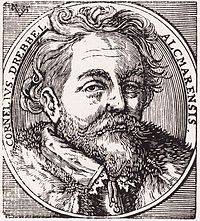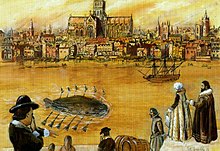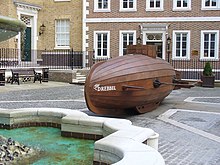Cornelis Drebbel
Cornelis Drebbel | |
|---|---|
 Portrait of Drebbel, c. 1631 | |
| Born | 1572 |
| Died | 7 November 1633 (aged 60–61) |
| Education | Hendrick Goltzius |
| Occupation(s) | Engineer, inventor |
| Spouse |
Sophia Jansdochter Goltzius
(m. 1595) |
| Children | 6 |
Cornelis Jacobszoon Drebbel.
Biography
Cornelis Drebbel was born in
In 1595 he married Sophia Jansdochter Goltzius, younger sister of Hendrick, and settled at Alkmaar. They had a minimum of six children, with four of them living.. Drebbel worked initially as a painter, engraver and cartographer. But he was in constant need of money because of the prodigal lifestyle of his wife [citation needed]. In 1598 he obtained a patent for a water-supply system and a sort of perpetual clockwork. In 1600, Drebbel was in Middelburg where he built a fountain at the Noorderpoort. In that spectacle-making center he may have picked up knowledge in the art of lens grinding[2] and later would construct a magic lantern and a camera obscura.
Around 1604 the Drebbel family moved to England, probably at the invitation of the new king,


His fame went through the courts of Europe. In October 1610 Drebbel and his family moved to
At the request of Roman-German Emperor Ferdinand II in 1619, he went to Prague again to tutor his sons and was taken prisoner after the Battle of White Mountain and the capture of Prague in 1620, where he also lost his fortune. In 1622 Constantijn Huygens stayed as a diplomat for more than one year in England. It is quite possible that he learned the art of glass grinding at this time from Drebbel, and that he passed this knowledge to his second son Christiaan Huygens, who became a prominent Dutch mathematician and scientist. The English natural philosopher Robert Hooke may have learned the art of glass grinding from his acquaintance Johannes Sibertus Kuffler, the son-in-law of Drebbel.[5]
Towards the end of his life, in 1633, Drebbel was involved in a plan to drain the Fens around Cambridge, while living in near-poverty running an ale house in England. He died in London.[6]
In keeping with traditional
Works
Drebbel was an empirical researcher and innovator. His constructions and innovations cover measurement and control technology, pneumatics, optics, chemistry, hydraulics and pyrotechnics. He registered several patents with the Dutch "Staten Generaal". He also wrote essays about his experiments with air pressure and made beautiful engravings; including The Seven Liberal Arts on a map of the city of Alkmaar. He was involved in making theater props, moving statues and in plans to build a new theater in London. He worked on producing torpedoes,
He was known for his Perpetuum Mobile, built an incubator for eggs and a portable stove/oven with an optimal use of fuel, able to keep the heat on a constant temperature by means of a regulator/thermostat. He designed a solar energy system for London (perpetual fire), demonstrated air-conditioning, made lightning and thunder ‘on command’, and developed fountains and a fresh water supply for the city of Middelburg. He was involved in the draining of the moors around Cambridge (the Fens), developed predecessors of the barometer and thermometer, and harpsichords that played on solar energy.
Chemistry
Drebbel's most famous written work was Een kort Tractaet van de Natuere der Elementen
Drebbel invented a chicken incubator and a mercury thermostat which automatically kept it stable at a constant temperature;[11] one of the first recorded feedback-controlled devices. He also developed and demonstrated a working air conditioning system. The invention of a working thermometer is also credited to Drebbel.[12]
Scarlet dye
The story goes that, while making a coloured liquid for a
Optics
Drebbel is credited with developing an automatic precision lens-grinding machine, improved telescopes, the first compound microscope ('lunette de Dreubells'),
Compound microscope
One of the optical devices some historians believe Drebbel invented when he was working for the Duke of Buckingham was the
Submarine


He also built the first navigable submarine in 1620 while working for the English Royal Navy.[23][24] He manufactured a steerable submarine with a leather-covered wooden frame. Between 1620 and 1624 Drebbel successfully built and tested two more submarines, each one bigger than the last. The final (third) model had 6 oars and could carry 16 passengers. This model was demonstrated to King James I in person and several thousand Londoners. The submarine stayed submerged for three hours and could travel from Westminster to Greenwich and back, cruising at a depth between 12 and 15 feet (4 to 5 metres). Drebbel even took King James in this submarine on a test dive beneath the Thames, making King James I the first monarch to travel underwater.[25] This submarine was tested many times in the Thames,[26] but it couldn't attract enough enthusiasm from the Admiralty and was never used in combat.
Cultural references
Cornelis Drebbel has been honoured on postage stamps issued by the postal services of both Mali and the Netherlands in 2010.[27]
A portrayal of Cornelis Drebbel and his submarine can be briefly seen in the film The Four Musketeers (1974). A small leatherclad submersible surfaces off the coast of England, and the top opens clamshell-wise revealing Cornelis Drebbel and the Duke of Buckingham.
Drebbel was honoured in an episode of the cartoon Sealab 2021 during a submarine rescue of workers on a research station in the Arctic. A German U-boat captain fired a pistol in celebration at the mention of Drebbel, to shouts of, "Sieg Heil! Cornelis Drebbel!" Also, on the Sealab 2021 Season 3 DVD, Cornelis Drebbel has two DVD commentaries devoted to the story of his life.
In the Dutch Eighty Years' War comic Gilles de Geus, Drebbel is a supporting character to the warhero Gilles. He is drawn as a crazy inventor, similar to Q in the James Bond series. His submarine plays a role in the comic.
Richard SantaColoma has speculated that the
Namesake
A small
Notes
- ^ In isolation, Jacobszoon is pronounced [ˈjaːkɔbzoːn].
References
- ^ "Drebbel's website www.drebbel.net". Retrieved 2010-08-06.
- ^ Gerrit Tierie, Cornelis Drebbel (1572-1633), H. J. Paris - 1932, page 47 [1]
- ^ "Tierie, Gerrit. Cornelis Drebbel. Amsterdam: HJ Paris, 1932" (PDF). Retrieved 2013-06-22.
- ^ G. van Enst Koning: Het Huis te Ilpendam en deszelfs voornaamste Bezitters. Uit echte bescheiden. In: De Gids – Nieuwe Vaderlandsche Letteroefeningen, Jg. 1837, S. 322–331 Online-version Dutch DBNL
- ^ Oxford Dictionary of National Biography: Cornelis Drebbel
- ^ "Drebbel's will from 7 November 1633: Memorand that Cornelius" (PDF). Drebbel.net. Retrieved 2016-01-06.
- ^ "My following children viz. John Dreble, Jacob Dreble, Cathryne Kiffler and Ann Kiffler" (PDF). Drebbel.net. Retrieved 2016-01-06.
- ^ Een Kort Tractaet van de Natuere der Elementen C. Drebbel, 1621
- ^ "Advanced Main Group Chemistry (I) – Rings, Chains, Clusters". 131.104.156.23. 2000-01-27. Archived from the original on 2004-07-07. Retrieved 2010-08-06.
- ^ F. Kurzer: “Fulminic Acid in the History of Organic Chemistry“, J. Chem. Educ. 2000, 77, 851
- ^ "Tierie, Gerrit. Cornelis Drebbel. Amsterdam: HJ Paris, 1932" (PDF). Retrieved 2013-05-03.
- ^ "Scientific American. / Volume 5, Issue 50, August 31, 1850". Memory.loc.gov. Retrieved 2010-08-06. [dead link]
- ^ A history of inventions and discoveries, Volume 2, Johann Beckmann, 1817
- ISBN 0-06-052275-5
- ^ "Johannes Siberius Kuffler (Pepys' Diary)". Pepysdiary.com. 15 March 2005. Retrieved 2016-01-06.
- ^ Jerome Ch'en, Nicholas Tarling, Studies in the Social History of China and South-East Asia: Essays in Memory of Victor Purcell, Cambridge University Press, Jun 10, 2010, page 215
- ISBN 978-90-6984-615-6.
- ISBN 978-1-4437-2594-1. Retrieved 2010-08-06.
- ISBN 978-90-6984-615-6.
- ^ Brian Shmaefsky, Biotechnology 101 - 2006, page 171
- ISBN 978-981-02-3781-3. Retrieved 2010-08-06.
- ^ "The Dawn of Microscopy, by David Bardell" (PDF). National Association of Biology Teachers. Archived from the original (PDF) on 2016-03-04. Retrieved 2016-01-06.
- ^ Davis, RH (1955). Deep Diving and Submarine Operations (6th ed.). Tolworth, Surbiton, Surrey: Siebe Gorman & Company Ltd. p. 693.
- OCLC 16986801. Archived from the original on 2011-09-05. Retrieved 2009-03-17.)
{{cite journal}}: CS1 maint: unfit URL (link - ^ "King James VI and I". Royal.gov.uk. Archived from the original on December 3, 2008. Retrieved 2010-08-06.
- ^ Kronyk der stad Alkmaer, Cornelis van der Woude - E. J. Visscher, 1725, p.191-192
- ^ "Postage Stamps". GAMEO. Retrieved 2016-01-06.
- ^ H. Richard SantaColoma. "New Atlantis Voynich Theory". santa-coloma.net. Retrieved January 27, 2013.
Sources
- BBC bio
- Andrew Szydlo, Water that does not wet hands, (Polish Academy of Sciences, 1994)
- Brett McLaughlin, Cornelis Drebbel and the First Submarine (1997)
- L.E. Harris, The Two Netherlanders, Humphrey Bradley and Cornelis Drebbel (Cambridge, 1961)
- (in Dutch) F.M. Jaeger, Cornelis Drebbel en zijne tijdgenooten, (Groningen, 1922)
- Who was Cornelis J. Drebbel ?
